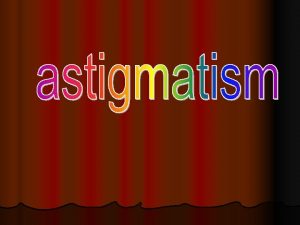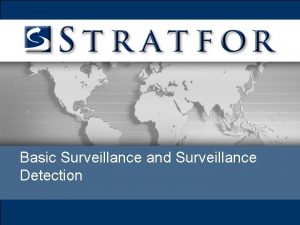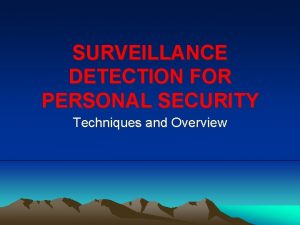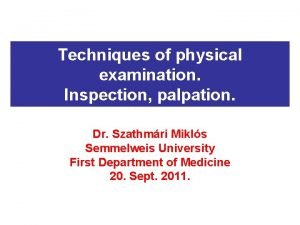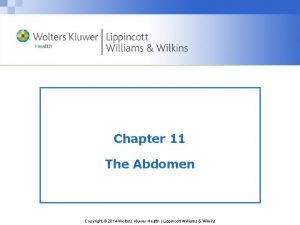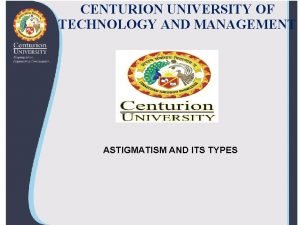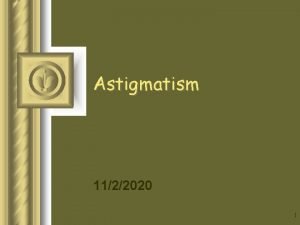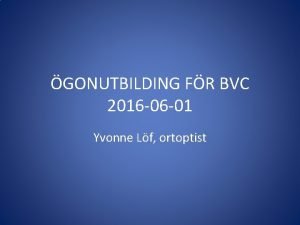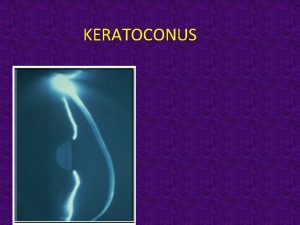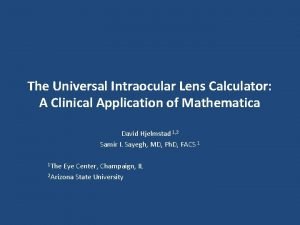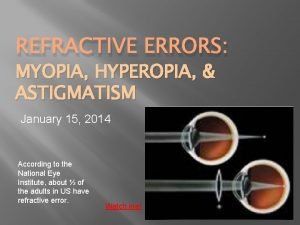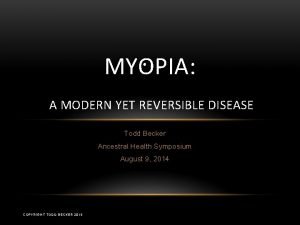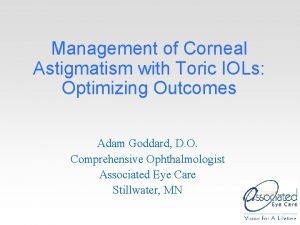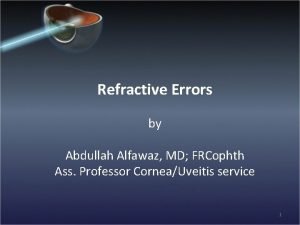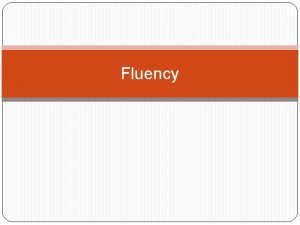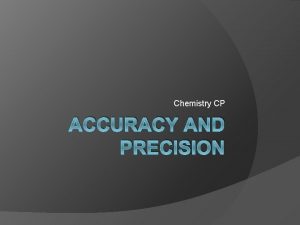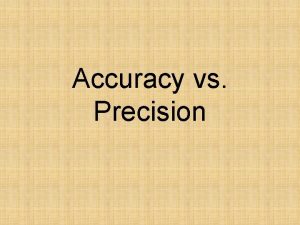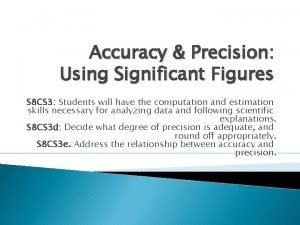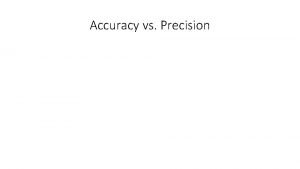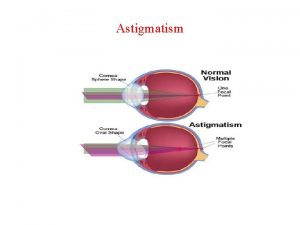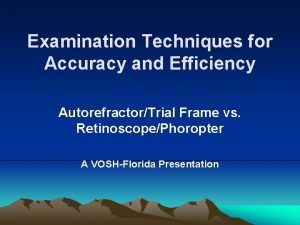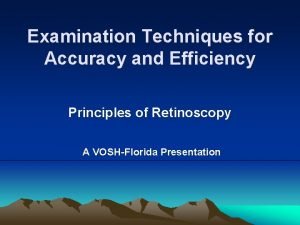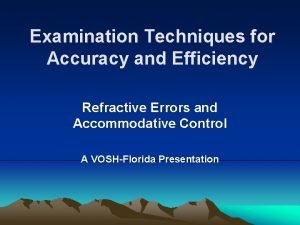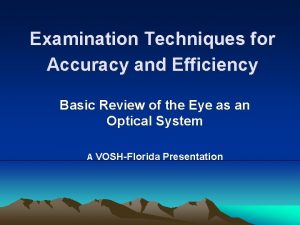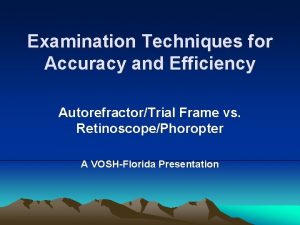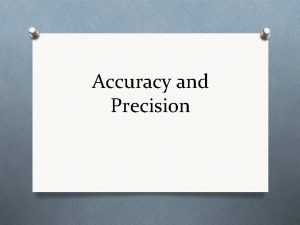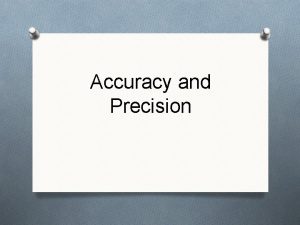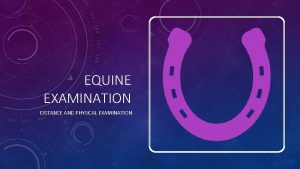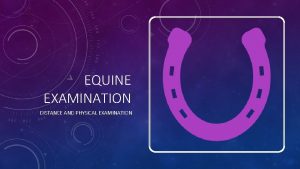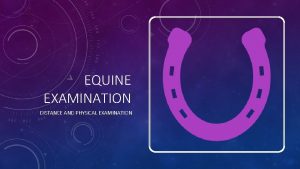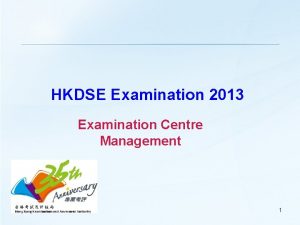Examination Techniques for Accuracy and Efficiency Astigmatism Detection
























- Slides: 24

Examination Techniques for Accuracy and Efficiency Astigmatism Detection and Management Options A VOSH-Florida Presentation

• • • Brief review of Astigmatism Measuring astigmatism using a retinoscope and lens (skioscopy) rack Measuring astigmatism using trial lenses Measuring astigmatism using a handheld Jackson Cross Cylinder (JCC) Refracting to spherical equivalence Prescribing Concerns

• Astigmatism: – generally defined as a non-spherical or toric anterior corneal curvature, resulting in incident rays of light having multiple points of focus: – Regular – Maximum and minimum refractive angles are separated by 90 degrees. – Irregular - Maximum and minimum refractive angles are separated by other than 90 degrees (pterygia, keratoconus, corneal scars). – Lenticular – astigmatism induced by a tilting of the crystalline lens (minimal, insignificant).

• Uncorrected Regular Astigmatism: – Results in a Circle of Least Confusion, or the dioptric midpoint between the major lines of focus.

• Uncorrected Astigmatism – Associated Clinical Symptoms : – Headaches/fatigue (squinting) – Distance blur – Near blur – Photophobia/glare – Night vision problems (blur/glare) – Pseudo-diplopia (ghost images)

• Measuring astigmatism using a retinoscope and lens (skioscopy) rack: – Place the trial frame on the patient. – Place your working distance trial lens over each eye (+1. 50 D for 65 cm). Do not occlude either eye. – Scope over the trial lens to determine the 2 principal meridians. – Hold up the lens rack (+ or – as needed) and scope the least minus or most plus meridian (strongest “against” motion or weakest “with” motion). – Move the lens rack to neutralize this meridian (“with motion” – add minus; “against motion” – add plus) – Add the appropriate spherical trial lens to the trial frame.

• Measuring astigmatism using a retinoscope and lens (skioscopy) rack – Next, hold up the lens rack (+ or – as needed) and scope the most minus or least plus meridian. – Move the lens rack to neutralize this meridian, which will show “with” motion. – Add the appropriate (-) cylinder trial lens to the trial frame at the determined axis.

• Measuring astigmatism using a retinoscope and lens (skioscopy) rack – Repeat this procedure with the other eye. – When both eyes have been refracted, remove the working distance lens from each eye. – Proceed with the subjective refraction.

• Measuring astigmatism using trial lenses – After obtaining the objective refraction using either a retinoscope or autorefractor (minus cylinder approach): • Place the spherical correcting lens in the trial frame for each eye. • Place the (-) cylinder correcting lens in the trial frame for each eye. • Occlude the eye not being tested. • Increase or decrease the sphere power for sharpest focus, bringing the Circle of Least Confusion onto the retina.

• Measuring astigmatism using trial lenses • Add a fogging lens of ~ +0. 50 diopters. • Slowly rotate the cylinder lens in the trial frame until the patient states that the acuity chart or meridian line on the astigmatic dial appears sharpest. • Increase or decrease the cylinder power to achieve sharpest focus, bringing the two principle meridians into focus in front of the retina. • Slowly reduce fog by decreasing (+) or increasing ( -) sphere power to achieve sharpest focus. Both principle meridians will be focused on the retinal plane at this point.

• Measuring astigmatism using a hand-held Jackson Cross Cylinder (JCC) – After obtaining the objective refraction using either a retinoscope or autorefractor (minus cylinder approach): • Place the spherical correcting lens in the trial frame for each eye. • Place the (-) cylinder correcting lens in the trial frame for each eye. • Occlude the eye not being tested. • Increase or decrease the sphere power for sharpest focus, bringing the Circle of Least Confusion onto the retina.

• Measuring astigmatism using a hand-held Jackson Cross Cylinder (JCC) • Add a fogging lens of ~+0. 50 diopters. • Hold the JCC with the axis mark aligned with the axis of cylinder trial lens. Flip the JCC. On the side giving the sharper image, rotate the trial lens axis towards the Red mark on the JCC (“Chase the red”). • When image appears equally blurred on flipping the JCC, the axis has been located.

• Measuring astigmatism using a hand-held Jackson Cross Cylinder (JCC) • Rotate the JCC, placing the power dot on the axis. • Flip the JCC. If red dot is sharper, add minus cyl. If white dot is sharper, reduce minus cyl. • For every increase of -0. 50 cyl, add +0. 25 to the sphere. • For every decrease of -0. 50 cyl, add -0. 25 to the sphere. • When image appears equally blurred on flipping the JCC, the power has been determined.

• Measuring astigmatism using a hand-held Jackson Cross Cylinder (JCC) • Remove the JCC • Slowly reduce fog by decreasing (+) or increasing ( -) sphere power to achieve sharpest focus. Both principle meridians will be focused on the retinal plane at this point. • Adjust for spherical equivalent if necessary.

• Refracting to Spherical Equivalence – Uncorrected Regular Astigmatism: • Results in a Circle of Least Confusion, or the dioptric midpoint between the major lines of focus.

• Refracting to Spherical Equivalence – The circle of least confusion is the point of least blur between the two principle meridians of an eye with regular astigmatism. – The closer the focal plane of each principle meridian to the other, the sharper the focus at the circle of least confusion. – When both principle meridians are focused at the same plane, circle of least confusion is at its sharpest focus.

• Refracting to Spherical Equivalence – The goal is to bring the circle of least confusion to sharpest focus and at the plane of the retina. – Refracting an astigmatic eye using sphere only correction will result in a less sharp image than a sphero-cylinder correction. – Sphere-only correction may be faster, cheaper, and provide adequate vision without adaptation problems.

• Refracting to Spherical Equivalence – Pros of sphere-only correction: • • Faster Less skill required Less expensive lenses Possibly less adaptation problems

• Refracting to Spherical Equivalence – Cons of sphere-only correction: • Possible symptoms: – Asthenopia – Accommodative spasms – Less sharp vision at distance and near

• Refracting to Spherical Equivalence – Refracting Methods: • Spherical trial lenses: – Find least minus or most plus sphere that provides sharpest image. • Retinoscope and trial lenses: – Scope principle meridians to determine sphero-cylinder correction. – Calculate spherical equivalent and place sphere lenses in trial frame. – Sphere + ½ Cylinder = Spherical Equivalent

• Refracting to Spherical Equivalence – Modified Spherical Equivalent Method: • Determine sphero-cylindrical correction. • Cut powers to maintain Circle of Least Confusion on retina. • Choose least cylinder that gives sharpest vision and comfort. – Reduce cylinder power by -0. 50 D, reduce sphere power by +0. 25 – Example: • +2. 00 – 1. 00 x 180 (sharpest image) • +1. 75 – 0. 50 x 180 (moderately sharp image) • +1. 50 sph (least sharp image)

• Refracting to Spherical Equivalence – Modified Spherical Equivalent Method: • By reducing the cylinder power, while maintaining the Circle of Least Confusion on the retina: – provides an acceptably sharp image. – reduces adaptation problems, while introducing cylinder. – eliminates asthenopia and accommodative spasms.

• Correcting Astigmatic Errors: – Adaptation/Prescribing Tips: • Small changes in cylinder power or axis can produce perceptual problems. • It may be necessary to introduce the cylinder correction gradually. • Prescribing reduced cylinder while maintaining the circle of least confusion on the fovea may improve adaptation.

• Correcting Astigmatic Errors: – Adaptation/Prescribing Tips: • Adults with chronic, uncorrected high astigmatism may not respond to cylinder correction due to the development of meridional amblyopia. • Prescribing increasing amounts of cylinder over time may aid in breaking down meridional amblyopia. • Younger patients will typically show with-the-rule astigmatism. • Older patients will develop against-the-rule astigmatism due to aging changes in the crystalline lens.
 L
L Allocative efficiency and productive efficiency
Allocative efficiency and productive efficiency Allocative efficiency vs productive efficiency
Allocative efficiency vs productive efficiency Productively efficient vs allocatively efficient
Productively efficient vs allocatively efficient Sdr surveillance detection route
Sdr surveillance detection route Vm detection techniques
Vm detection techniques Surveillance detection techniques
Surveillance detection techniques Physical exam abdomen
Physical exam abdomen Wolters kluwer
Wolters kluwer With the rule astigmatism
With the rule astigmatism With the rule astigmatism
With the rule astigmatism With the rule astigmatism
With the rule astigmatism Tvångshuvudhållning
Tvångshuvudhållning Oil droplet reflex keratoconus
Oil droplet reflex keratoconus Astigmatism fix calculator
Astigmatism fix calculator Astigmatism
Astigmatism What is print pushing
What is print pushing Astigmatism
Astigmatism Astigmatism symptoms
Astigmatism symptoms Les fonctions techniques et les solutions techniques
Les fonctions techniques et les solutions techniques Fluency def
Fluency def Define accuracy in chemistry
Define accuracy in chemistry Accuracy v precision
Accuracy v precision Precision and significant figures
Precision and significant figures Uncertainty multiplication and division
Uncertainty multiplication and division
